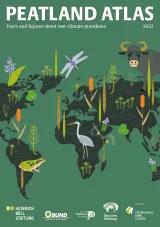
Europe is rich in peat landscapes, which differ widely according to the region and climate. But one thing that the European Union’s programmes to protect peatlands have in common is that they are not very effective.

Peatlands cover a total of 35 million hectares in the European Union (EU). The EU country with the highest proportion of peatlands is Finland, where peat covers around 25 percent of the land surface. Some 20 percent of Ireland and Estonia are covered by peat, followed by Sweden with 15 percent. Uncertainties in data show that the figures are not directly comparable between countries. For example, peatlands are not designated as such in some countries.
Peatlands in the European Union have a long land use history. Around half of the peatlands are classified as degraded due to peat extraction and drainage for agriculture or forestry. Southern Europe has the highest proportion of degraded peatlands, although this region also has more peatlands in protected areas, for example in EU Natura 2000 sites. LIFE, the EU’s programme for nature, is also financing peatland projects across EU, but their spatial extend remains limited. Most intact areas where peat is still accumulating are located in the northern parts of the continent. In the European Union, around 120,000 hectares, or just under one percent of the total drained area, has so far been rewetted.
The European Union has a concerted agricultural policy for the last 60 years – the Common Agricultural Policy (CAP). With an annual budget of 55 billion euros, it has a major influence on the direction of agriculture. The use of drained peatlands is fully eligible for support, whereas rewetting has in the past usually led to a loss of support due to the change of use involved. Only 12 of the EU’s 27 Member States have included peatland conservation in their national plans for implementing the CAP. And on only two percent of peatlands water abstraction via drainage is banned. Between 2014 and 2020, only 2,500 hectares were actively restored under the CAP.
With the start of a new funding period in 2023, it is now possible for Member States to subsidize rewetted areas via the CAP’s direct payments mechanism. That makes raising the soil water levels more attractive to farmers, but at the same time payments for drained agricultural sites continue. Also, scientists say that the protection of peatlands in national implementation plans is far from sufficient, with only a minority of Member States making use of this option.
Beyond the flat-rate area payments, there are at least some promising efforts to improve the situation of peatlands in the EU through targeted support measures such as organic farming schemes and agri-environmental and climate schemes. But it is still too early to judge their success. This will depend largely on the budget available and farmers’ acceptance of the tailored measures.
The European Green Deal is more promising to bring about a change in the right direction as it covers biodiversity, land use and soil policies in a coherent manner. As part of the deal, the European Commission proposed the Nature Restoration Law in June 2022. This aims to set concrete, legally binding goals for restoring ecosystems for the Member States. The proposal includes a special role for peatlands. It requires that the Member States step by step restore 70 percent of their degraded and agriculturally used peatlands by 2050, half of it through rewetting. Yet this law has seen strong resistance by parts of the EU legislator. The Council of the EU has adopted its position in June 2023, yet introduced more flexibility for Member States. It has also reduced the area of peatlands, which has to be restored to 50 percent. The European Parliament on the other hand has completely deleted the peatland restoration targets as part of agricultural lands in its position. Trilogue negotiations between Parliament, Council and EU Commission are ongoing, yet it can be expected that the final law will be less ambitious than the original proposal by the EU Commission. Scientists and environmental NGOs state that even with the Commission’s proposal an insufficient area of peatlands would be rewetted to reach overarching goals for example for climate action or biodiversity conservation.
European legislation requires individual Member States to balance emissions and carbon storage in their land use. Despite the current rules, emissions from drained peatlands have not yet decreased significantly. Peatlands in the European Union currently emit 220 million tonnes of CO₂-equivalent per year. Overall, drained peatlands are responsible for 7 percent of the EU’s greenhouse gas emissions – they are by far the largest source of emissions from agricultural land use and forestry.


